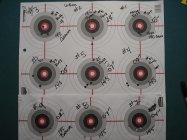I'm completely sympathetic to the idea that components are so hard to come by that it is painful to burn ammo and bbls on load development. I just don't know how to avoid it when pushing performance comes up or when the bullets or the barrels are unknown.
I think the only way to avoid a lot of it is to stick with standardized high quality barrels and chambers. That is possible in some games, but not in all. Things would get boring fast if we only shot the same things. Then along come politics, and here we are.
So, for next time when/if things loosen up... some food for thought...
Consider the differences in test methods, one being the test style where you take a stab at some seating depths and shoot groups, the other where you take a wide sweep with a long string of very fine steps.
What I have observed, is that folks tend to try and minimize the number of shots by putting too much space between seating depths being tested. The result can be hit an miss by getting unlucky where those selected seating depth intervals may land slightly off the nodes or the harmonics and you miss the beat.
I would suggest that the very fine step single sweep has been a better method for me, than attempting groups with coarse steps.
The fine steps tend to show if there is actually a stable node that would be durable, and also tend to uncover more than one node in most instances. Then I go back and verify that selected seating depth with groups and test for the boundaries of that node to know when I should consider re-tuning.
This means the steps fine, like no more than 0.005" per step, and sometimes they are just 0.003" per step. The sweeps can be wide in situations where we have no background with the chamber or barrel, in other words when we don't already have a pretty good idea. When a barrel is a copy of one we know, we can get away with a narrower sweep.
I realize that if you make the seating depth steps smaller between groups, the two methods tend to merge, but by then you are also burning lots more rounds than necessary.
I also find that folks tend to run these group style tests at shorter distances to try and avoid with effects. A fine step string is best run at the longest important distance while only considering vertical, and then verified with group testing with the best results from the fine step string.
Some bullets and jumps are known to play well together, others are unknowns. If you take the example of a 6mm Berger 105 Hybrid, there is some similarity between many different cartridges using that same bullet that would tend to say the bullet doesn't mind being jumped. You can see this in the Precision Rifle Blog Seating Depth articles to some extent. I'll link one below and you will find the rest on that site.
https://precisionrifleblog.com/2020/03/21/bullet-jump-and-seating-depth-reloading-best-practices/
https://precisionrifleblog.com/2020/04/05/bullet-jump-load-development-data/
https://precisionrifleblog.com/2020/04/15/18-shot-bullet-jump-challenge/
https://precisionrifleblog.com/2020/03/29/bullet-jump-load-development/
I will also add that with the Barnes TSX and TTSX, I was surprised at the jump those liked, but as an R&D guy I learned to avoid my own bias and trust the results. It turned out for me, that this observation has repeated across many rifles and different cartridges.
Along the lines of trusting those results, I noticed the advise given by
@46and2 to be sure to clean well between switching brands of jacket materials. I realize Matchburners are not the same jacket material as their monolithic copper bullets, but I found that I did have an effect from jumping between bullets and powders when they were not similar and I have made it my own policy to clean well if I am switching between bullet brands or even powder types (ball to extruded for example).
When I was younger, I tried to get away with thrown ball powder charges for shorter line ammo, then switch to extruded for the longer distances. In more than one rifle, I learned I didn't get away with that unless I cleaned well between those relays where I was switching powder or bullet types. So now I just caution you to run that testing yourself some day, but for now start with a clean bbl when you are making type changes of powder or bullet materials.
Again, just food for thought. YMMV











